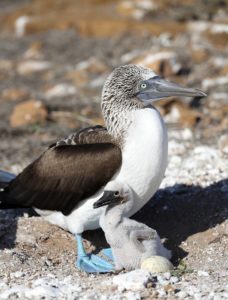The first Nazca Booby hatchling usually kills its nestmate the first chance it gets – denying it food and pushing it out of the nest until it starves. By taking the initiative, the early hatchling promotes its own survival at the expense of its sibling’s. The Nazca Booby’s cousin, the Blue-footed Booby, is not quite so harsh. When the chicks are hatchlings, the parents go out of their way to assure that both survive, and most of the time they do. (Lougheed & Anderson 1989). But when times are especially lean, the first Blue-footed Booby to hatch will nonetheless kill its sibling before fledging, assuring itself a heftier meal and increasing its own likelihood of survival (Anderson 1989).
Siblicide presents a conflict for the avian parents, potentially pitting their evolutionary interests against those of their progeny. The parents benefit when they produce the maximum number of surviving offspring, while an individual hatchling strongly benefits from being an only child, receiving all of the attention and not having to share its food. When food is plentiful, the better outcome for the parents is the survival of both hatchlings. When food is particularly scarce, the dominant chick may only be able to survive without the competition from its sibling. In this way, the approach of the Blue-footed Booby seems to respond to the circumstances.For both species, which lay one to three eggs, the opportunity to treat their progeny differently is created by asynchronous hatching. The first chick has time to strengthen and grow before it has any competition. The lag time between the emergence of the first and second hatchlings is much greater for the Nazca Boobies, which minimize wasted resources by allowing almost immediate reduction of their broods to one. Blue-footed Boobies, however, support both progeny until later in their development when it is perhaps easier to determine whether there is enough food to go around. With closer birthdays, their progeny are on more equal footing.
Literature
Anderson, D.J. (1989) The role of hatching asynchrony in siblicidal brood reduction of two booby species. Behav. Ecol. Sociobiol. 25: 363-368.
Lougheed, L.W. & Anderson, D.J. (1999) Parent blue-footed boobies suppress sibilicidal behavior of offspring. Behav. Ecol. Sociobiol. 45: 11-18.

